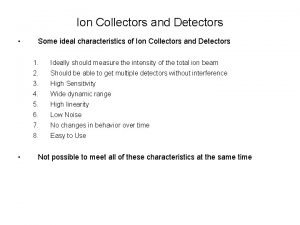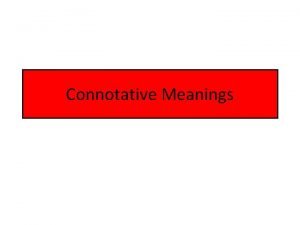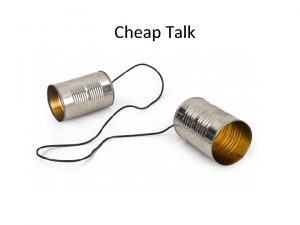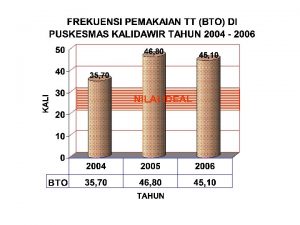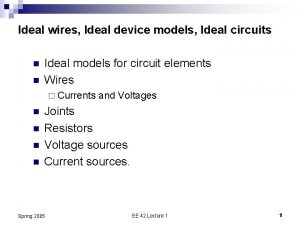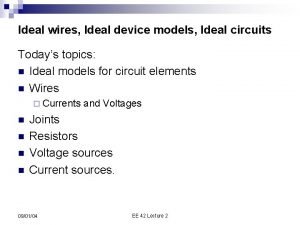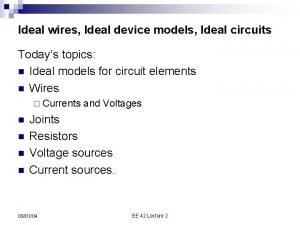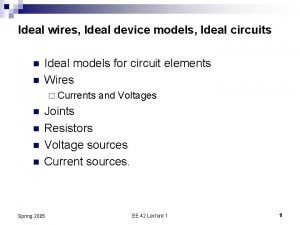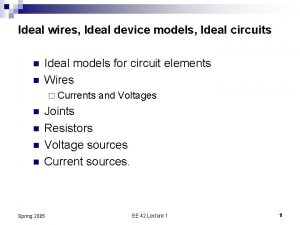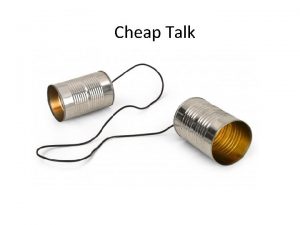Ideal Detector Fast Cheap Rugged Responds to all



























- Slides: 27


Ideal Detector • • Fast Cheap Rugged Responds to all wavelengths of light Can distinguish different wavelengths Sensitive Low LOD

Photoelectric Effect • Light consists of particles (photons). The energy of each is proportional to their frequency. • A certain minimum amount of energy (dependent on the material) is necessary to remove an electron from the surface of a zinc plate or another solid body (workfunction). • If the energy of a photon is bigger than this value, the electron can be emitted. • A large number of lower energy photons are not able to remove an electron.

Photoelectric detectors • Light is shone on a photoemissive cathode • The number of electrons emitted is proportional to the radiant power. • The electrons are collected at an anode (held at a more positive potential). • Both are sealed in an evacuated envelope. • Called a phototube.

• As the voltage difference between anode and cathode increases, more electrons are collected, • until • About 50 V where the signal no longer increases with V • Then the current is proportional to radiation intensity • The current is not sensitive to wavelength • (within certain limits)

Photomultiplier tube • Current produced in phototube is small – requires amplification • Add a series of DYNODES between cathode and anode – each at a successively higher V • Each emits several electrons when hit by an energetic (accelerated) electron • Cascade effect • Big signal



PMT’s • Fast response times (~10 -8 sec) • Show a dark current (a small background current even in the dark) • Mostly from thermionic emission – can overcome by cooling • Some from natural radioactivity and cosmic radiation

Photon Counting • Usually output of PMT is averaged over time. • But in low light the electrical pulses produced by each photon can be counted. • Improved S/N and precision • Good for low light – Fluorescence • Detector is more complex, expensive


P-type semiconductor • The addition of trivalent impurities such as • boron, aluminum or gallium to an intrinsic • semiconductor creates deficiencies of • valence electrons, called "holes". • It is typical to use B 2 H 6 (diborane gas) to diffuse boron into the silicon material.

N-type semiconductor • The addition of pentavalent impurities such as antimony, arsenic or phosphorous contributes free electrons, greatly increasing the conductivity of the intrinsic semiconductor. • Phosphorous may be added by diffusion of phosphine gas (PH 3).



Reverse bias

Reverse biasno current flows and there is a region formed without charge carriers Depletion layer

• When radiation hits the depletion layer, holes and electrons are formed and a current flows. • The current is proportional to P (power of incident radiation)



Photodiode array – a row of photodiodes – all on a chip


Diode arrays • Used with a grating which disperses the light so each ‘wavelength’ falls on a different photodiode. • Grating doesn’t move • No slits i. e. no monochromator • Spectral scans are very fast • Good as chromatography detectors or fast kinetics


Charge-Coupled Detector • A CCD is an integrated-circuit chip that contains an array of capacitors that store charge when light creates e-hole pairs. The charge accumulates and is read in a fixed time interval. • CCDs are used in similar applications to other array detectors such as photodiode arrays, although the CCD is much more sensitive for measurement of low light levels.


 Photodiode array
Photodiode array Ideal characteristics of a detector
Ideal characteristics of a detector Eizo rugged solutions
Eizo rugged solutions Rugged individualist archetype examples
Rugged individualist archetype examples Jesus prince of peace glory hallelujah
Jesus prince of peace glory hallelujah Praise and honour unto thee
Praise and honour unto thee Man of sorrows lamb of god
Man of sorrows lamb of god Rugged countenance
Rugged countenance Acid fast vs non acid fast
Acid fast vs non acid fast Acid fast vs non acid fast
Acid fast vs non acid fast Why the body responds to stimuli.
Why the body responds to stimuli. Name three lines
Name three lines Flesh and blood so cheap
Flesh and blood so cheap Green sand casting definition
Green sand casting definition Pasadena water and power
Pasadena water and power Cheap hotels in darfur
Cheap hotels in darfur Cheap talk game theory
Cheap talk game theory Betty bought butter tongue twister
Betty bought butter tongue twister Tube bundle heat exchanger
Tube bundle heat exchanger An inspector calls opening stage directions
An inspector calls opening stage directions High security fence systems
High security fence systems But these girls arent
But these girls arent Remifentanil infusion rate
Remifentanil infusion rate Glidants in tablets
Glidants in tablets Moneysupermarket cheap car insurance
Moneysupermarket cheap car insurance Comparative of regular
Comparative of regular Cheap denotation and connotation
Cheap denotation and connotation Cheap talk movie
Cheap talk movie

